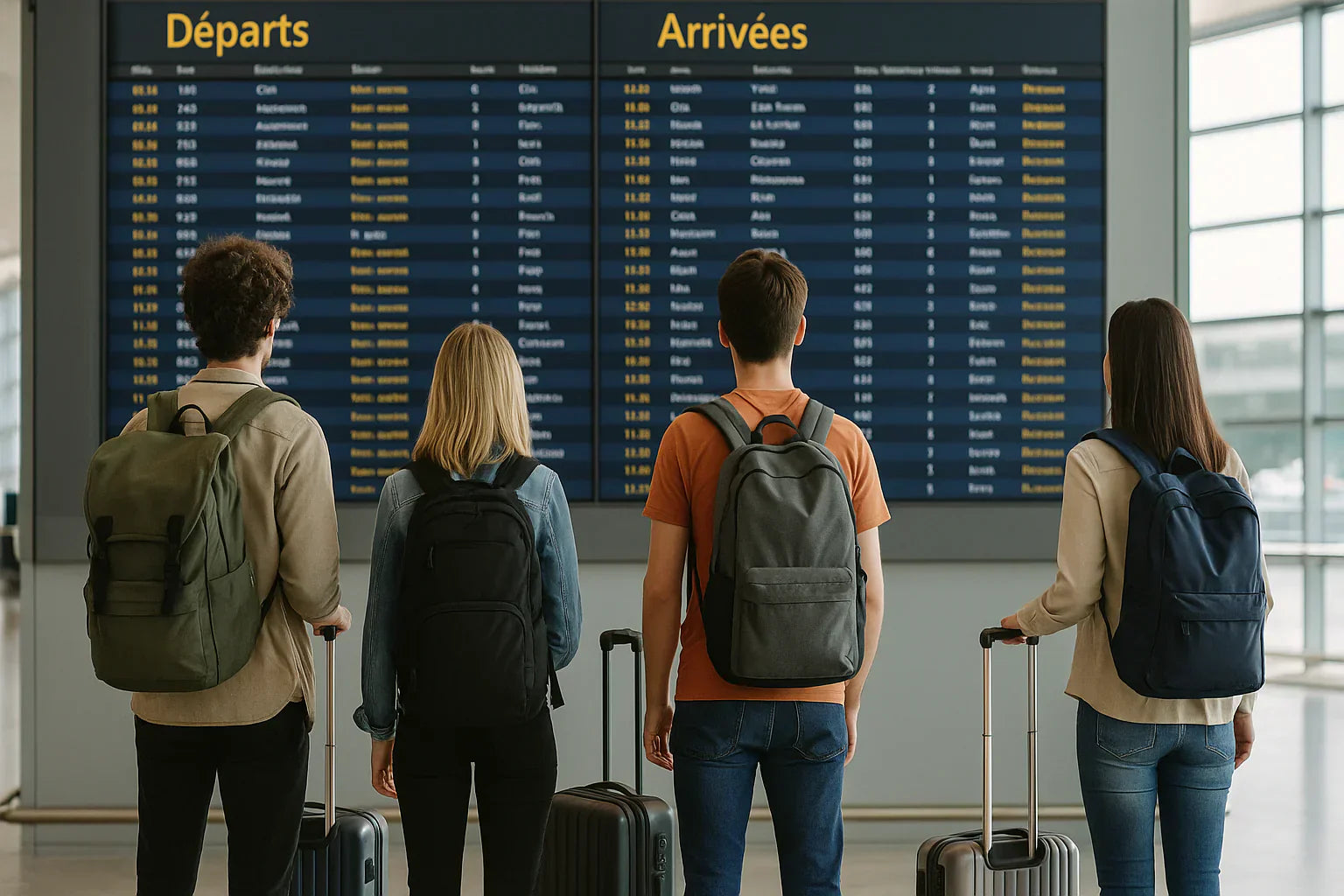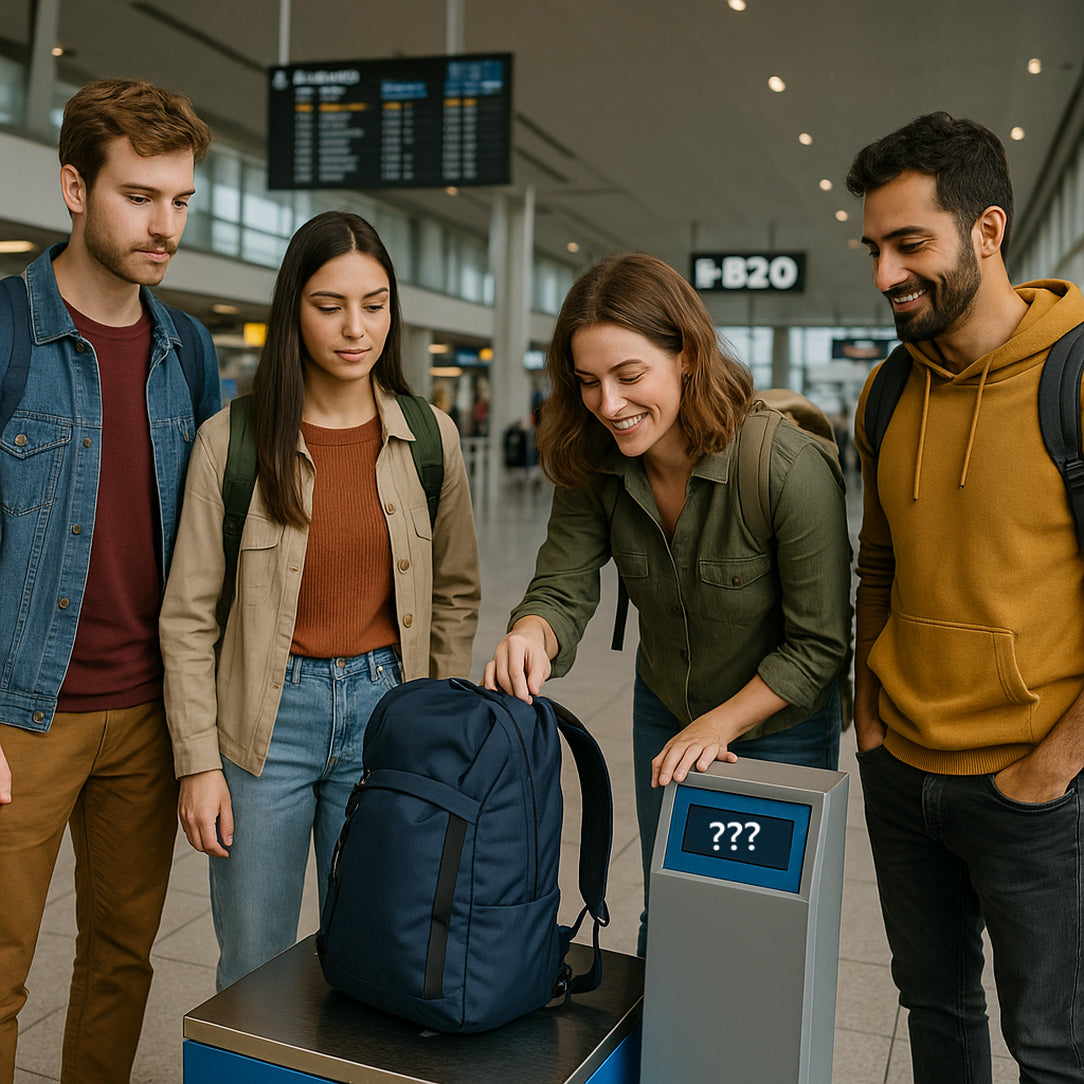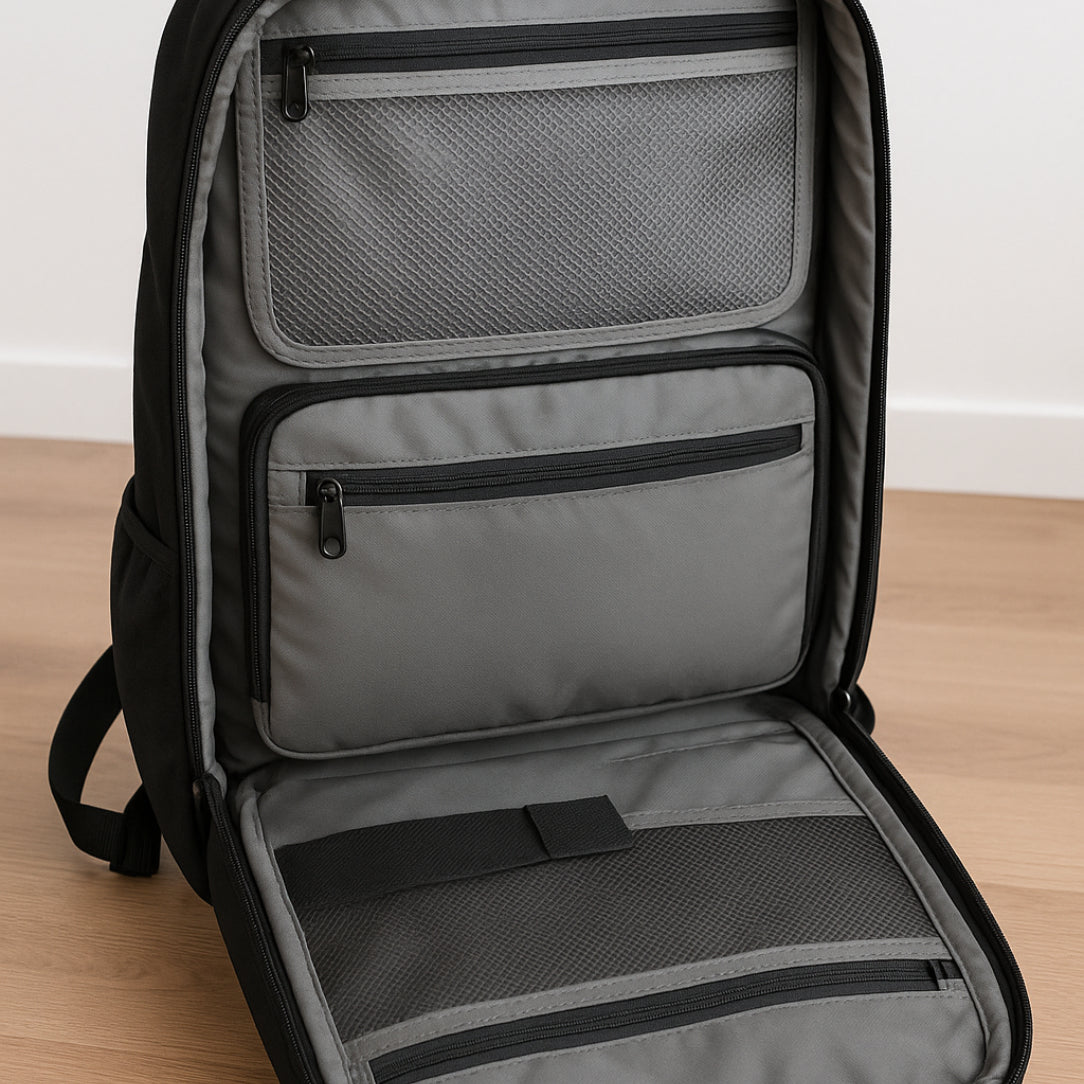Article: How to choose the right cabin backpack?

How to choose the right cabin backpack?
Choosing your cabin backpack can prove difficult between the dimensions imposed by airlines and the precise requirements for the plane.
Discover here the rules you need to know for a hassle-free trip, including the correct dimensions , maximum weight allowance, and suitable bag types. With this information, you'll easily identify carry-on luggage that meets your needs and current regulations.
Summary
- Regulations for cabin backpacks
- Maximum weight allowed for cabin baggage
- Types of backpacks suitable for air travel
- Compartments and important features
- Comfort and ergonomics for long journeys
- Materials and durability of cabin backpacks
Regulations for cabin backpacks
Standard cabin backpack dimensions are around 55 x 40 x 20 cm or 55 x 35 x 25 cm. These sizes correspond to a maximum volume of approximately 44 to 48 liters , sufficient for a trip of a few days. Depending on the airline, the exact measurements may vary slightly.
The permitted dimensions vary depending on the airline. For example, Air France allows 55 x 35 x 25 cm luggage, while EasyJet allows 56 x 45 x 25 cm. Some low-cost carriers, such as Ryanair, impose stricter restrictions. It is therefore essential to always check your airline's rules before departure.
| Airline | Maximum dimensions (cm) | Maximum weight allowed (kg) |
|---|---|---|
| Air France | 55 x 35 x 25 | 12 |
| Lufthansa | 55 x 40 x 23 | 8 |
| Emirates | 55 x 38 x 20 | 7 |
| Ryanair | 55 x 40 x 20 | 10 |
| EasyJet | 56 x 45 x 25 | Not specified |
| British Airways | 56 x 45 x 25 | 23 |
| Turkish Airlines | 55 x 40 x 23 | 8 |
| Iberia | 56 x 40 x 25 | 10 |
| Wizz Air | 55 x 40 x 23 | 10 |
| Volotea | 55 x 40 x 20 | 10 |
| TAP Air Portugal | 55 x 40 x 25 | 10 |
| Thai Airways | 56 x 45 x 25 | 7 |
| Transavia | 55 x 35 x 25 | 10 |
| Eurowings | 55 x 40 x 23 | 8 |
| Corsair | 55 x 40 x 20 | 12 (total cabin baggage + personal baggage) |
It's important to check your airline's size restrictions before departure. A non-compliant travel bag may be refused in the cabin, resulting in checked baggage fees. Sizes vary by airline, with common standards around 55x40x20 cm or 56x45x25 cm.
Dimensions in centimeters are converted to liters by multiplying the height by the width and depth. For example, 55x40x20 cm gives 44 liters , a common volume for carry-on luggage. This calculation helps you choose a bag that suits your needs without exceeding the permitted limits.
A bag that does not meet the size requirements may be refused in the cabin and sent to the hold for an additional fee. Some airlines charge this fee at boarding, at a higher rate than when purchasing the ticket. The generally accepted dimensions are around 55x40x20 cm or 55x35x25 cm.

Maximum weight allowed for cabin baggage
Carry-on baggage weight limits vary between airlines. On average, economy class passengers can carry between 7 and 12 kg . Some low-cost carriers impose stricter restrictions, such as a maximum of 10 kg on Ryanair or 8 kg on Emirates.

The travel class influences the baggage allowance. In business class, passengers often benefit from more generous allowances. Air France allows 18 kg in the cabin for its Business class compared to 12 kg in economy. Emirates offers up to 50 kg in First Class.
To stay within the limits, distribute the weight among passengers . If each person carries 10 kg according to the rules, you have a total of 20 kg. Share items such as chargers or toiletries.
To check the weight, use your bathroom scale and weigh yourself with and without the bag. Subtract your body weight to get the exact mass . Allow a margin of 0.5 to 1 kg to avoid any surprises.
Exceeding the limits will incur additional fees at the airport , often higher than booking in advance. Your luggage may also be refused in the cabin and have to be checked in, sometimes at a high price.
Avoid unnecessary items that unnecessarily weigh down your luggage. Leave paper books, metal tools, full bottles, cooking utensils and heavy clothing at home to travel light .
Types of backpacks suitable for air travel

The market offers various types of cabin backpacks suitable for air travel . Soft-sided models offer flexibility to meet size restrictions. Hard-sided versions provide better protection for fragile items. Some bags combine wheels and shoulder straps for added versatility. Expandable models adapt to different luggage volumes.
To choose the right backpack, consider the pros and cons of each type. Soft-sided bags fit easily into tight spaces but offer less protection. Hard-sided models better protect fragile equipment but lack flexibility. Hybrid backpacks with wheels make travel easier but can be bulky. Expandable versions adapt to your needs but can encourage overpacking.
- Extremely practical for public transport and stairs
- Adjustable capacity thanks to compression straps
- Fits standard cabin dimensions (55x40x20 cm)
- Compressible to comply with volume limits (40-48L)
- Limited adaptation to telescopic handles
- They protect fragile items like laptops
- Optimized organization with separate compartments
- Shock and weather resistant for cabin travel
- Heavy and impractical on rough terrain
- Lack of flexibility in urban mobility
Soft-sided bags are distinguished by their adaptability to cabin baggage restrictions. Their flexibility allows them to be easily slipped under seats or into overhead compartments. These models are suitable for travelers seeking lightweight and maneuverable luggage. They are perfect for short trips or urban travel.
Hard-shell bags are ideal for travelers carrying fragile equipment. Their reinforced structure protects laptops, cameras , and valuables. These models are popular with professionals traveling with expensive equipment. They offer good internal organization but lack flexibility.
Hybrid bags with wheels combine practicality and comfort. These models can be carried like a backpack or rolled like a suitcase. They make getting around airports and train stations easier . These bags adapt to the various needs of business or family trips.
Expandable bags adapt to changing needs. Their adjustable volume is ideal for round-trips with bulky return luggage. These models expand to accommodate purchases on the way back. They are perfect for itineraries with multiple stops or long trips.
Compartments and important features

A padded compartment effectively protects your laptop during transport. This specially designed pocket minimizes the risk of damage to your device. It also facilitates airport security checks by keeping the computer accessible without having to remove everything.
Travel documents need quick access. Opt for a front or side pocket for tickets, passport, and boarding pass. Avoid hiding them deep inside your bag to save time at security and while traveling.
Separating wet and dry areas prevents unpleasant surprises. A waterproof pouch for liquids protects the rest of the contents. This organization also makes storage and cleaning easier , especially after using the toilet.
Compression straps tighten the contents for a compact volume. These systems optimize space and stabilize belongings inside. A good system prevents clutter and helps to comply with maximum cabin dimensions.
The expandable side pockets hold bottles, umbrellas, or chargers. They offer immediate access without having to rummage through the bag. Opt for elastic materials to secure different sizes of items depending on their use.
Innovations are modernizing the travel experience. Some bags include USB ports or RFID protection. These technological features secure data and simplify the use of electronic devices on the go for greater convenience.
Comfort and ergonomics for long journeys
- The padded, adjustable shoulder straps distribute weight evenly across your shoulders, minimizing pressure points and chafing. For added comfort, check the strap width and padding before purchasing.
- The waist belt transfers the main weight to the hips and abdomen. It stabilizes the pack during movement. For heavy loads, a thick, adjustable waist belt is recommended for greater comfort.
- The back ventilation system limits perspiration between the back and the pack. Ventilation channels or mesh panels improve comfort. For travel in warm climates, choose packs with breathable mesh.
Place heavy items close to your back for better stability. Centralized weight distribution prevents imbalance and reduces fatigue. Distribute the weight evenly for smoother, less tiring carrying.
Choose a travel backpack that suits your body type. Back lengths vary between models. For optimal carrying comfort, check the height and width according to your measurements before purchasing.
Test the loaded bag to simulate real-world conditions. Walk, bend, and turn to check the balance. A good fit is characterized by stability and comfort, even when loaded.
Materials and durability of cabin backpacks
Backpacks use a variety of materials: ballistic nylon for its durability, recycled polyester (rPET) for its eco-friendliness, and hybrid combinations to balance performance and lightness. Depending on the model, these materials influence the durability, water resistance , weight, and aesthetics of the travel bag.
For a smooth trip, keep three priorities in mind: check the exact dimensions according to the airline, opt for a lightweight and structured bag, and prioritize models with practical compartments. By choosing a suitable cabin backpack , you'll enjoy greater comfort and avoid unnecessary expenses. Prepare for your next trip with complete peace of mind: every detail counts for traveling light, efficiently, and stress-free.
